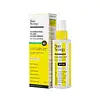What's inside
What's inside
 Key Ingredients
Key Ingredients

 Benefits
Benefits

 Concerns
Concerns

 Ingredients Side-by-side
Ingredients Side-by-side

Water
Skin ConditioningEthylhexyl Salicylate
UV AbsorberButyl Methoxydibenzoylmethane
UV AbsorberOctocrylene
UV AbsorberGlycerin
HumectantBetaine
HumectantCoco-Caprylate
EmollientZinc Oxide
Cosmetic ColorantStearic Acid
CleansingPhenoxyethanol
PreservativeCetyl Alcohol
EmollientGlyceryl Stearate
EmollientAmmonium Acryloyldimethyltaurate/Vp Copolymer
Propylene Glycol
HumectantMenthol
MaskingMethyl Diisopropyl Propionamide
MaskingEthyl Menthane Carboxamide
TonicMenthyl Lactate
MaskingHydroxypropylcellulose
EmulsifyingTocopheryl Acetate
AntioxidantAloe Barbadensis Leaf Extract
EmollientChamomilla Recutita Flower Extract
MaskingAvena Sativa Kernel Extract
AbrasiveCaesalpinia Spinosa Fruit Extract
Skin ProtectingHelianthus Annuus Sprout Extract
Skin ConditioningCitrus Aurantium Dulcis Peel Oil
MaskingRosmarinus Officinalis Leaf Oil
MaskingSodium Benzoate
MaskingDisodium EDTA
Sodium Hydroxide
BufferingWater, Ethylhexyl Salicylate, Butyl Methoxydibenzoylmethane, Octocrylene, Glycerin, Betaine, Coco-Caprylate, Zinc Oxide, Stearic Acid, Phenoxyethanol, Cetyl Alcohol, Glyceryl Stearate, Ammonium Acryloyldimethyltaurate/Vp Copolymer, Propylene Glycol, Menthol, Methyl Diisopropyl Propionamide, Ethyl Menthane Carboxamide, Menthyl Lactate, Hydroxypropylcellulose, Tocopheryl Acetate, Aloe Barbadensis Leaf Extract, Chamomilla Recutita Flower Extract, Avena Sativa Kernel Extract, Caesalpinia Spinosa Fruit Extract, Helianthus Annuus Sprout Extract, Citrus Aurantium Dulcis Peel Oil, Rosmarinus Officinalis Leaf Oil, Sodium Benzoate, Disodium EDTA, Sodium Hydroxide
Water
Skin ConditioningGlycerin
HumectantCetearyl Olivate
Sorbitan Olivate
EmulsifyingEthylhexyl Methoxycinnamate
UV AbsorberGlyceryl Behenate
EmollientButyl Methoxydibenzoylmethane
UV AbsorberSodium Polyacrylate Starch
AbsorbentBenzophenone-3
UV AbsorberButylene Glycol
HumectantPhenoxyethanol
PreservativeEthylhexylglycerin
Skin ConditioningButyloctyl Salicylate
Skin ConditioningPhospholipids
Skin ConditioningSodium Gluconate
Skin ConditioningTriethanolamine
BufferingAcrylates/C10-30 Alkyl Acrylate Crosspolymer
Emulsion StabilisingWater, Glycerin, Cetearyl Olivate, Sorbitan Olivate, Ethylhexyl Methoxycinnamate, Glyceryl Behenate, Butyl Methoxydibenzoylmethane, Sodium Polyacrylate Starch, Benzophenone-3, Butylene Glycol, Phenoxyethanol, Ethylhexylglycerin, Butyloctyl Salicylate, Phospholipids, Sodium Gluconate, Triethanolamine, Acrylates/C10-30 Alkyl Acrylate Crosspolymer
 Reviews
Reviews

Ingredients Explained
These ingredients are found in both products.
Ingredients higher up in an ingredient list are typically present in a larger amount.
Also known as Avobenzone, this ingredient is a chemical sunscreen filter that provides protection in the UV-A range.
Avobenzone is globally approved and is the most commonly used UV-A filter in the world.
Studies have found that avobenzone becomes ineffective when exposed to UV light (it is not photostable; meaning that it breaks down in sunlight). Because of this, formulations that include avobenzone will usually contain stabilizers such as octocrylene.
However, some modern formulations (looking at you, EU!) are able to stabilize avobenzone by coating the molecules.
Avobenzone does not protect against the UV-B range, so it's important to check that the sunscreen you're using contains other UV filters that do!
The highest concentration of avobenzone permitted is 3% in the US, and 5% in the EU.
Learn more about Butyl MethoxydibenzoylmethaneGlycerin is already naturally found in your skin. It helps moisturize and protect your skin.
A study from 2016 found glycerin to be more effective as a humectant than AHAs and hyaluronic acid.
As a humectant, it helps the skin stay hydrated by pulling moisture to your skin. The low molecular weight of glycerin allows it to pull moisture into the deeper layers of your skin.
Hydrated skin improves your skin barrier; Your skin barrier helps protect against irritants and bacteria.
Glycerin has also been found to have antimicrobial and antiviral properties. Due to these properties, glycerin is often used in wound and burn treatments.
In cosmetics, glycerin is usually derived from plants such as soybean or palm. However, it can also be sourced from animals, such as tallow or animal fat.
This ingredient is organic, colorless, odorless, and non-toxic.
Glycerin is the name for this ingredient in American English. British English uses Glycerol/Glycerine.
Learn more about GlycerinPhenoxyethanol is a preservative that has germicide, antimicrobial, and aromatic properties. Studies show that phenoxyethanol can prevent microbial growth. By itself, it has a scent that is similar to that of a rose.
It's often used in formulations along with Caprylyl Glycol to preserve the shelf life of products.
Water. It's the most common cosmetic ingredient of all. You'll usually see it at the top of ingredient lists, meaning that it makes up the largest part of the product.
So why is it so popular? Water most often acts as a solvent - this means that it helps dissolve other ingredients into the formulation.
You'll also recognize water as that liquid we all need to stay alive. If you see this, drink a glass of water. Stay hydrated!
Learn more about Water